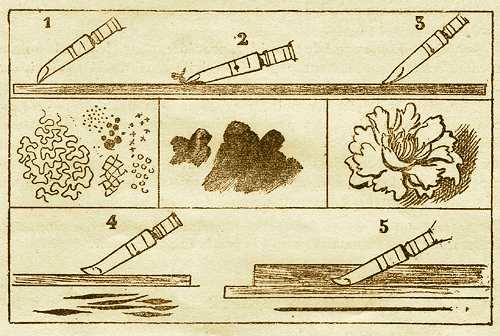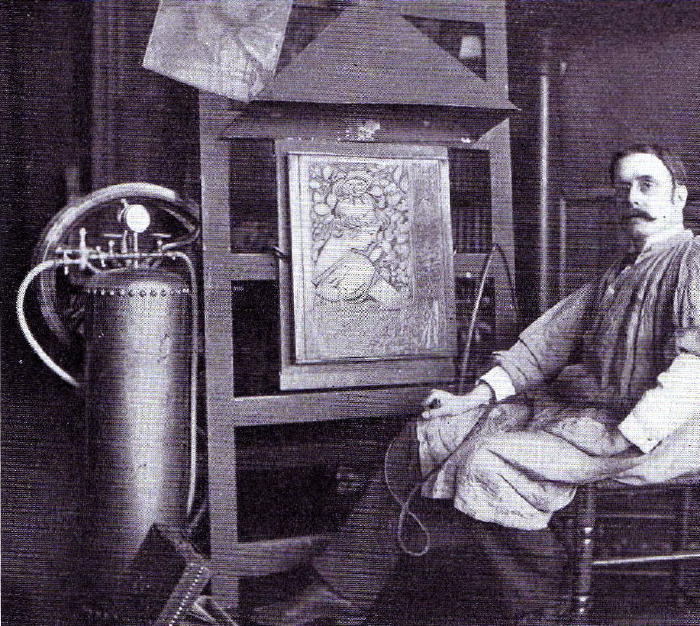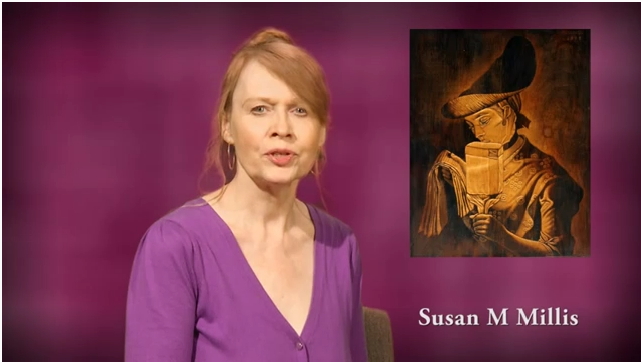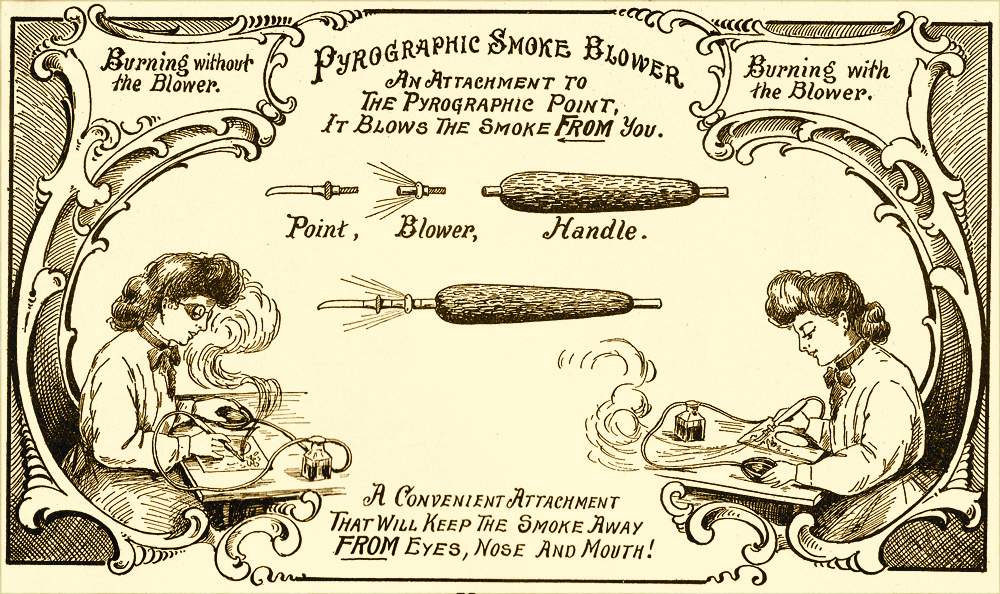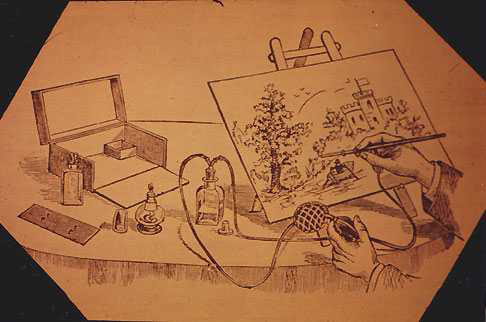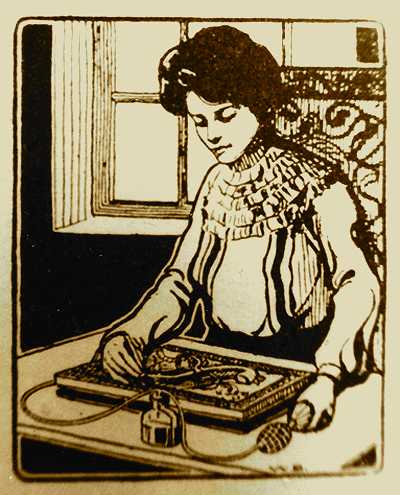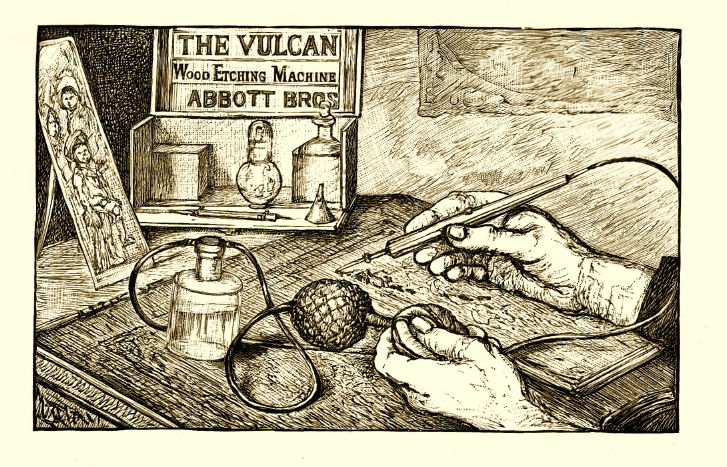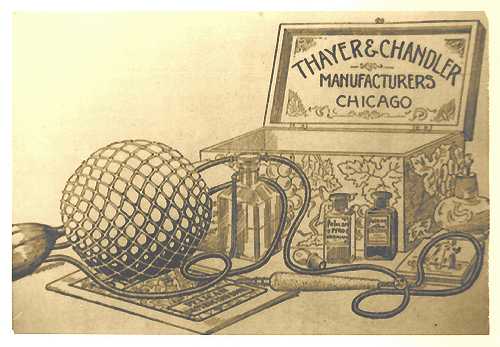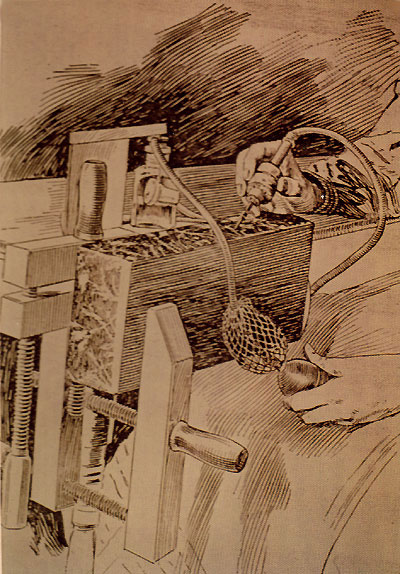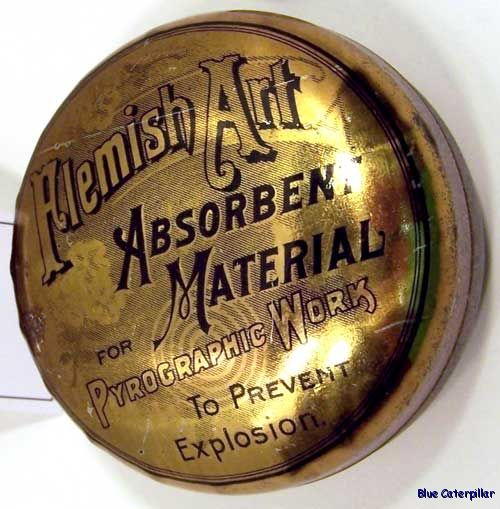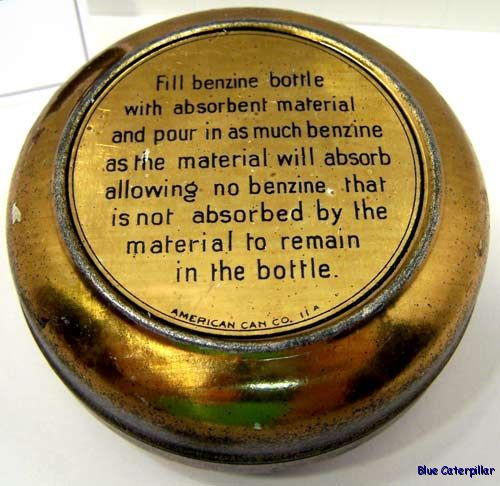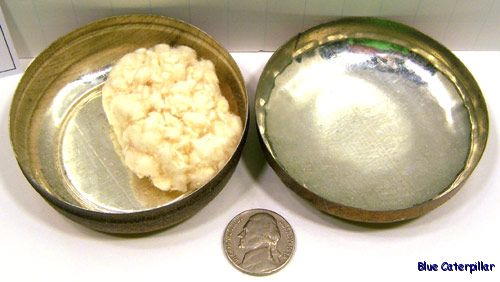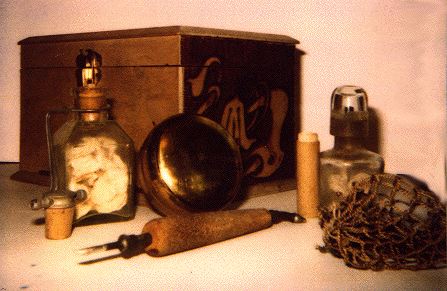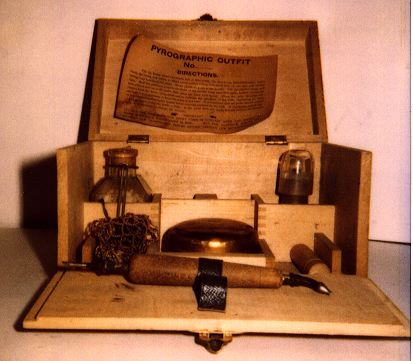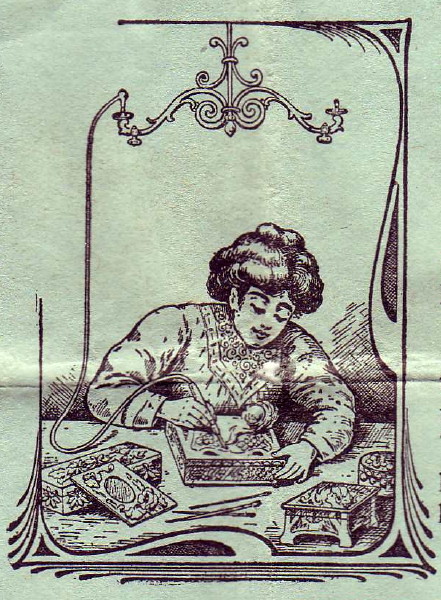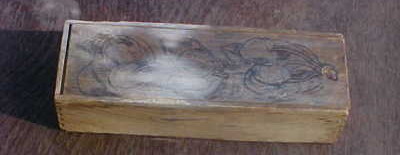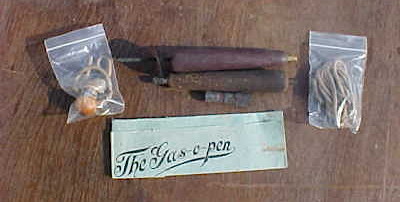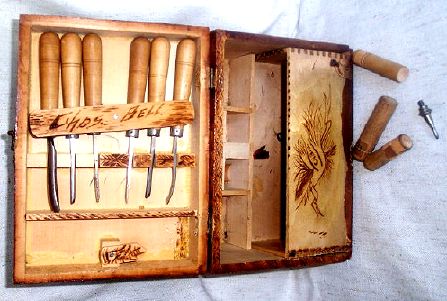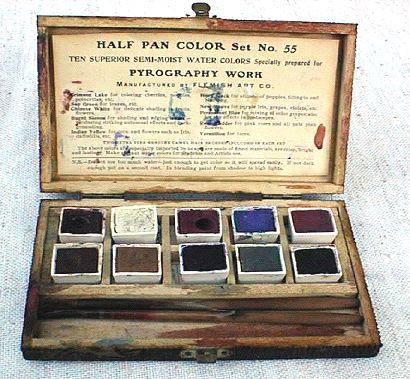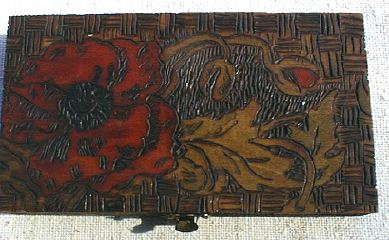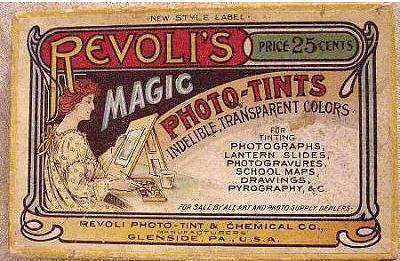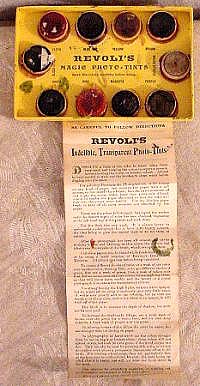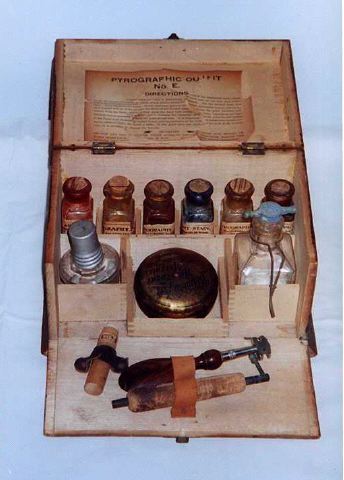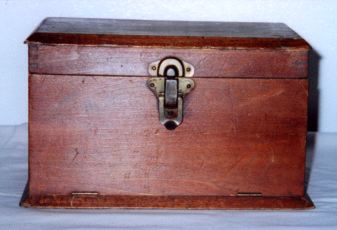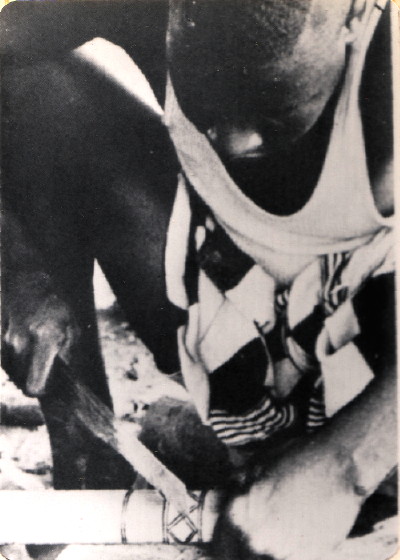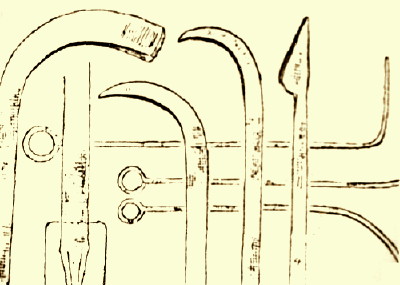Exhibit
Back to E-Museum Entrance
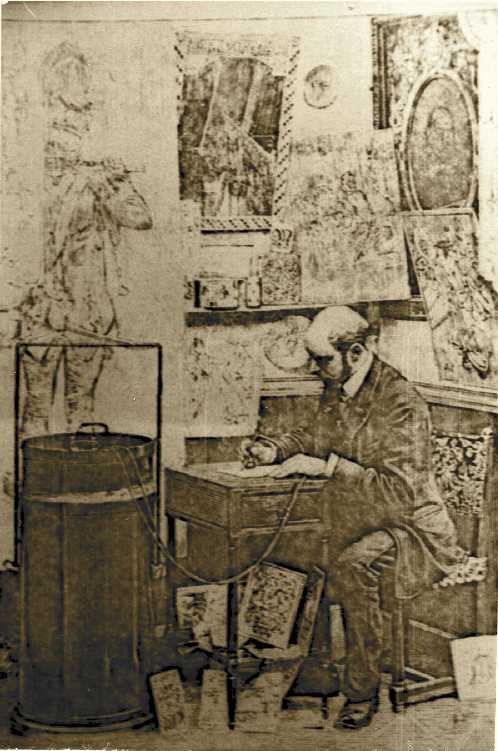
|
French Pyrographer Demonstrating a Large Model
of Manuel-Perier's Pyrographic Tool
From an 1890 French Journal
"Until approximately 1887, woodburning was done with heated pokers, knives, pins and needles. For small pictures, metal skewers wrapped in asbestos or encased in wood were used. The pins were heated in a small coal stove or on a spirit lamp. Constantly changing heat and the lack of uniform points plagued all early pyrographers.
This situation quickly improved when a French physician, Dr. Claude Pacquelin, invented a cauterization machine in 1875. At the International Exposition in 1889 in Paris, pyrographer François Manuel-Perier demonstrated his adaptation of Pacquelin's tool. The tool consisted of an insulated handle with a platinum tip, which was kept hot by a gaseous mixture [naphtha]. A source of constant heat and uniform tips had now been found.
News of Manuel-Perier's methods quickly spread. Soon artists in Germany and Austria were selling pyrographed souvenirs to tourists and collectors. Americans also brought back early pyrography outfits. Widespread appreciation for burnt wood extended to England and then America." —John P. Lewis
Photograph and text with permission of John P. Lewis, ©1979
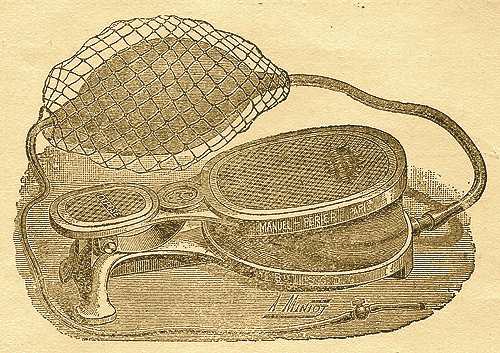
|
Bellows Worked by Foot with a Simple Pedal
(Soufflerie au pied à simple pédale)
for Manuel-Perier's Pyrographic Tool
"Designers or amateurs can adapt this bellows to diverse tools. For them it has the advantage of allowing them to have both hands free. The spring pedal does not cause fatigue in the foot of the user.
This bellows is cast metal with rubber fittings; it is recommended for its durability. It is equipped with connecting tubes and a large rubber reservoir for air enclosed in a net. It can be used while standing or seated." —Manuel-Perier
Drawing and text from a circa 1890 French booklet entitled,
La Pyrogravure: Notice pour le fonctionnement des Appareils à Pyrograver
(Pyrography: Notes on the Use of Pyrography Tools), p. 13.

|
Handle with Insulated Point Holder
(Manche à Griffe Isolante)
for the Manuel-Perier Pyrographic Tool
"The insulating grip, which keeps the handle of the pyropen from getting hot, makes it possible to hold it close to the point and to handle this light tool like an ordinary pencil.." —Manuel-Perier
Drawing and text from a circa 1890 French booklet entitled,
La Pyrogravure: Notice pour le fonctionnement des Appareils à Pyrograver
(Pyrography: Notes on the Use of Pyrography Tools), p. 16.
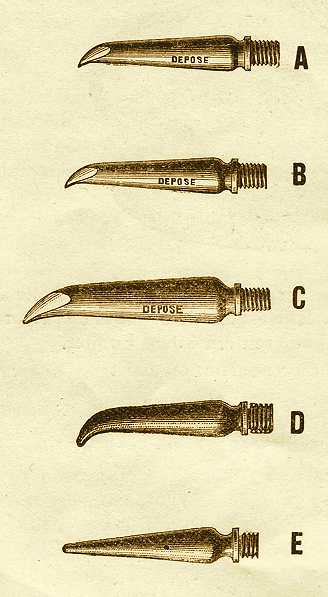
|
Divers Formats des Pointes en Platine Pour Pyrocrayon
(Various Shapes of Platinum Points for the pyroPEN)
for Manuel-Perier's Pyrographic Tool
"All the points of the pyropen can be attached to the same handle.
The Universal Point, specially adapted for all types of work in pyrography, comes in three shapes as pictured.
The fine point A is used for works in which the details require a very fine line or points.
The medium point B is the standard point that comes with all the tools. With practice and a light hand that can be acquired readily, this point is adequate for a wide range of works. Delicate and fine lines, as well as the softest or strongest effects can be obtained without difficulty using the Universal Point B.
The heavy point C is used principally for heavier works or for pyroengraved works with a very deep line. It can likewise be used for pyroengraving quickly an extensive background design.
Point D is used for works that are extremely fine.
The conical point E is used especially for writing."
—Manuel-Perier
Drawing and text from a circa 1890 French booklet entitled,
La Pyrogravure: Notice pour le fonctionnement des Appareils à Pyrograver
(Pyrography: Notes on the Use of Pyrography Tools), p. 14.
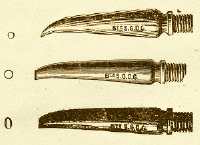
|
Divers Formats des Pointes en Platine Pour Pyropinceau
(Various Shapes of Platinum Points for the PyroPAINTBRUSH)
for the Manuel-Perier Pyrographic Tool
"Just like the pyroPEN in shape and size, the pyroPAINTBRUSH differs from the former in the construction of its platinum tip. The latter, which works without contact, is open at the end to allow the passage of a hot air jet, burning and coloring from a distance.
The Pyropaintbrush serves especially well in the execution of landscapes in order to obtain the softer, muted tones of skies, running water, distant landscapes, etc. It produces the effect of a paintbrush.
As can be observed, the pyropaintbrush is an accessory designed under a totally different principal than the pyropen." —Manuel-Perier
Drawing and text from a circa 1890 French booklet entitled,
La Pyrogravure: Notice pour le fonctionnement des Appareils à Pyrograver
(Pyrography: Notes on the Use of Pyrography Tools), p. 15.
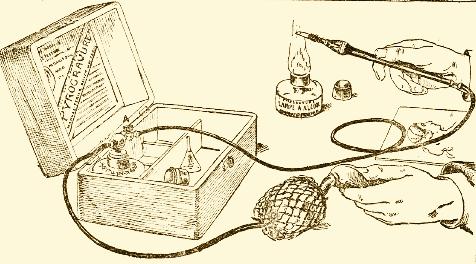
|
Demonstration of the Set-up of the Pyrotool at the Moment of Lighting
A smaller model of the Manuel-Perier Pyrographic Tool
Drawing and text from a circa 1890 French booklet entitled,
La Pyrogravure: Notice pour le fonctionnement des Appareils à Pyrograver
(Pyrography: Notes on the Use of Pyrography Tools)
Use of Points Illustrated for French Pyrotool
Drawing from a circa 1890 French booklet entitled,
La Pyrogravure: Notice pour le fonctionnement des Appareils à Pyrograver
(Pyrography: Notes on the Use of Pyrography Tools)
Detail View of J. Wm. Fosdick's German Pyrotool
Thanks to earlier writings by and about J. William Fosdick that have more recently come to light,
it is now believed that his thermo-pyrography tool may well have been German rather than French,
as was first supposed. Certainly it can be observed that there are marked differences between the
one displayed here and Manuel-Perier's French tool that opens this exhibit.
Update, January 2013:
A DOCUMENTARY FILM
Featuring Susan Millis Demonstrating
an Antique Pyrography Tool
CLICK ON THE LINK HERE TO SEE SUSAN MILLIS'S
short documentary film—RESEARCH IN ACTION—PYROGRAPHY—
demonstrating and describing an antique pyrography tool.
A film with Gary McConville, Cameraman and Editor
from Bucks New University of High Wycombe, Buckinghamshire, U.K.
THE PYROGRAPHIC SMOKE BLOWER
An innovative feature that was offered in the catalogue
of W. L. Milner & Co. of Toledo, Ohio, U.S.A.
A Smaller, More Portable Model French Pyrographic Kit
Photograph with permission of John P. Lewis, ©1979
French Lady Using a Pyrography Kit
Photograph with permission of John P. Lewis, ©1979
The Vulcan Wood Etching Machine
Illustration by William Freeman from the Maud Maude book
of a demonstration of the pyrography tool
manufactured by Abbott Bros. in the U.K.
Thayer & Chandler Pelican Pyrography Kit
Chicago, Illinois, U.S.A., circa 1905
Photograph with permission of John P. Lewis, ©1979
An Illustration of a Pyrographer Working
with an Early Pyrographic Outfit
"A wood vise provided a third hand."
Photograph and text with permission of John P. Lewis, ©1979
Absorbent Material for Pyrographic Work To Prevent Explosion
Flemish Art Co. accessory for use with their thermo-pyrography tool
American Pyrographic Tool Kit, in two views
Early 20th century
From the estate of the late Hazel Schmoll
On display at the Boulder Museum of History
Boulder, Colorado
Photographs by Jehnie Burns
Thanks to The Boulder Museum of History for the photos of their recently acquired pyrographic kit dating from the beginning of this century. If you're in Colorado, stop by and see the historic Harbeck-Bergheim House displaying Boulder's history from the conquest of the American West to the beginning of the space-age.
This museum is part of the Colorado Alliance of Research Libraries (CARL) and has many of its photos digitized for access by patrons from across the nation. It is located at 1206 Euclid Avenue, Boulder, Colorado 80302-7224, tel. (303) 449-3464.
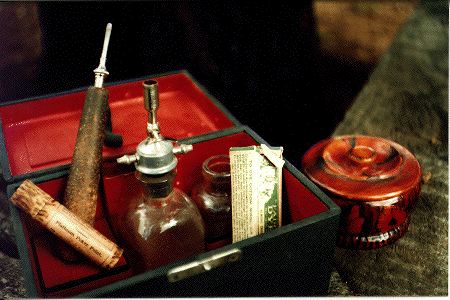 |
Australian Pyrographic Tool
Early 20th Century
Photo by K. J. Mixo Sydenham
Thanks to Jan Crawford from Bairnsdale, Australia, for the above picture from her private collection.
|
Manual of Instructions for Use
Accompanying Australian Pyrographic Tool
Early 20th Century
Photo by K. J. Mixo Sydenham
Thanks to Jan Crawford from Bairnsdale, Australia, for the above picture from her private collection.
Demonstration of the GAS-O-PEN
from The Flemish Art Co., 1907
The GAS-O-PEN Set
from The Flemish Art Co., 1907
Two pens with wood handles in a small wooden box with a sliding lid. A long cord for attaching to a light fixture where there is a gas flame, and a green sheet with instructions for use.
This is a very rare example of a pyrography tool designed to be connected directly to a gas jet. Because of its rarity, conjecture has it that, although it was inexpensive and simple, it was not received well by the public, who were perhaps fearful of the idea of using gas in this way. Another possible reason for its demise and disappearance was that widespread use of electricity became the norm, rendering this gas method obsolete. Since it was an inexpensive tool to begin with, most were likely discarded. Click on the link to see the instruction sheet for this rarity of pyrographic tools.
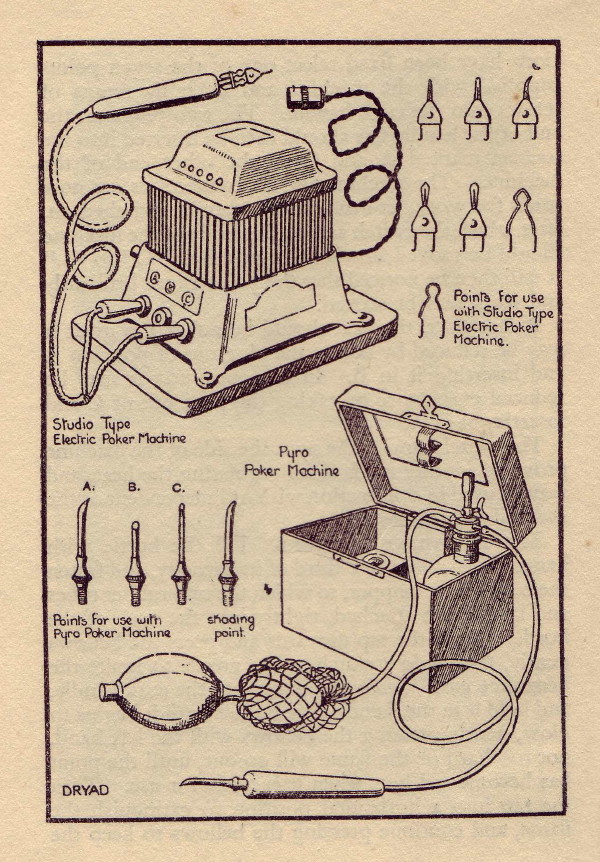 |
The Electric Poker Machine and the Benzoline Machine
Two Tools from England Illustrated in a 1929 Book
It is surprising that the electric poker machine, as the first of the two unusual machines depicted is called, seems to have wire tips rather than solid ones at this early date. These were found illustrated on p. 20 in a book entitled "Poker Work" by E. Mochrie and U. R. Fletcher, and published by Dryad Press, in 1929.
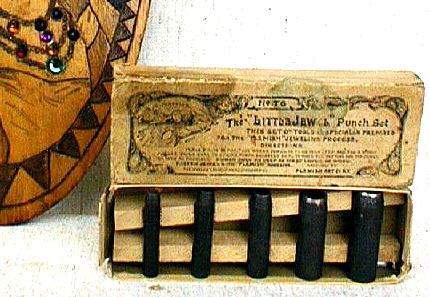 |
The Little Jewel Punch Set, No. 76
Flemish Art Co. of N.Y.
Early 20th Century
On the box are the following directions:
"The Little Jewel Punch Set (No. 76) made only by the Flemish Art Co.
Place punch where jewel is to be inserted and use a wooden mallet, being sure
to strike punch squarely so as to make the setting for the jewels as even
as possible. Punch only as deep as first layer of wood. Fasten jewels with
FLEMISH Adhesive."
Image thanks to Peni Powell
From the private collection of Peni Powell, whose website is linked here. In addition, Peni Powell has pieces from her collection of Flemish Art poker work from the turn of the century downstairs in the Antique Hall of the E-Museum. Included in that exhibit is the plaque with the inlaid jewels partially visible here.
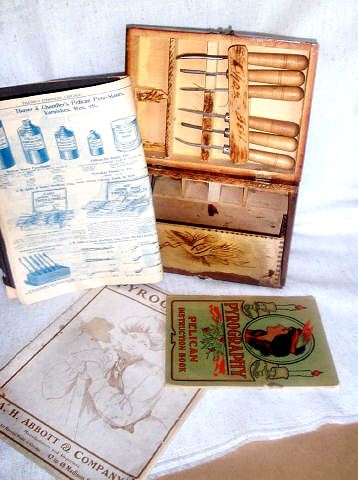 |
Carving Set and Catalogues and Instruction Books
Early 20th Century
Image thanks to Peni Powell
From the private collection of Peni Powell, whose website Palette of Colors is linked here. A selection of pieces from her collection of Flemish Art is displayed downstairs in the Antique Hall of the E-Museum.
Carving Set
Flemish Art Co. of N.Y.
Early 20th Century
Image thanks to Peni Powell
From the private collection of Peni Powell, whose website Palette of Colors is linked here. A selection of pieces from her collection of Flemish Art is displayed downstairs in the Antique Hall of the E-Museum.
Half Pan Color Set No. 55
Open view of box showing paints, above
Ten Superior Semi-Moist Water Colors
Specially prepared for Pyrography Work
Flemish Art Co. of N.Y.
Early 20th Century
Closed view showing decorated box, below
Image thanks to Peni Powell
From the private collection of Peni Powell, whose website is linked here. In addition, Peni Powell has pieces from her collection of Flemish Art poker work from the turn of the century downstairs in the Antique Hall of the E-Museum.
Revoli's Magic Photo-Tints, Box Cover
Revoli Photo-Tint & Chemical Co., Glenside, Pennsylvania, U.S.A.
Early 20th Century
Revoli's Magic Photo-Tints, Ten Tints and Instructions Inside Box
Revoli Photo-Tint & Chemical Co., Glenside, Pennsylvania, U.S.A.
Early 20th Century
Pyrographic Outfit No. E
Open view showing bottled paints and pyrographic set, above
Early 20th Century
View of closed box, below
Private collection, contact Curator.
African Pyrographer at Work
"Primitive way of decorating wood which is still used today"
Photograph adapted, with permission
of John Lewis, © 1979
From a photograph courtesy of Van Nostrand Reinhold Co.
Nineteenth Century African Tools
Drawing of pokers and pointers used to decorate wood
From an 1887 London newspaper
Adapted, with permission, from a photograph by John Lewis, © 1979
For more about antique pyrographic tools and art work, there is a fully illustrated article entitled Antique Pyrography (published in the WWWoodcarvers Online Magazine, linked here) about the past of pyrographic art and tools.
You are leaving
the Antique Pyrography Tools Exhibit.
You can return to the:
Pyrography Tools Main Exhibit Hall
or go directly to the
Pyrography Tools of Today Exhibit.
If you have completed your visit to
the Pyrography Tools Exhibit,
you can continue on your tour to
one of the following:
Pyrographic Art Exhibit Halls:
Please e-mail the E-Museum Curator with comments or questions. In addition, if you know of any tools that have been omitted, please do not hesitate to advise the curator. It is the E-Museum's goal to exhibit as complete a collection as possible.
Back to E-Museum Entrance homepage
© 1997, 2000, 2003, 2007, 2009, 2010, 2013 Kathleen M. Garvey Menéndez,
all rights reserved. Updated 15 October 2010. Last updated 24–28 January 2013.







